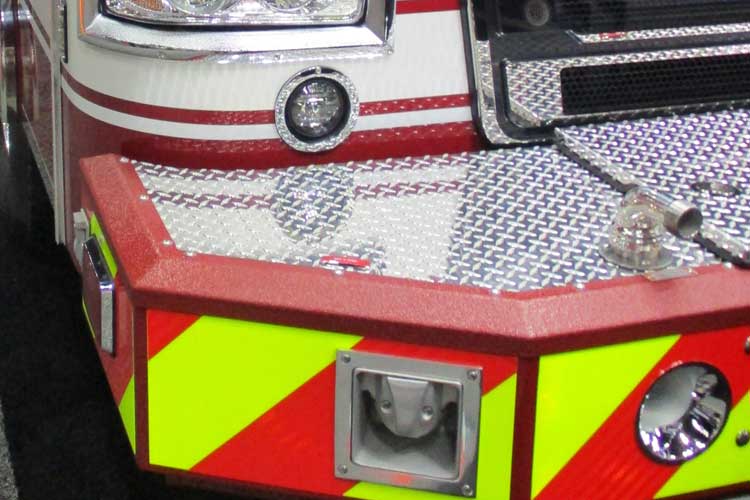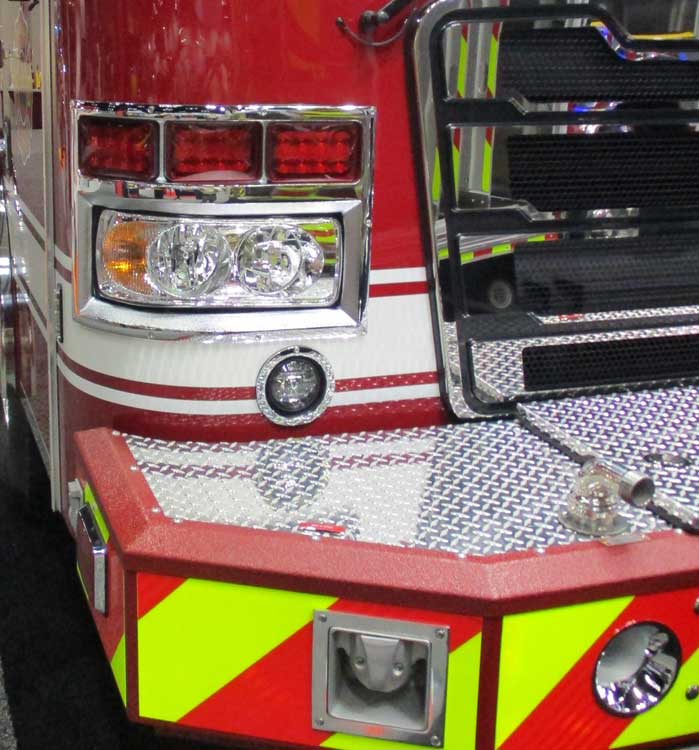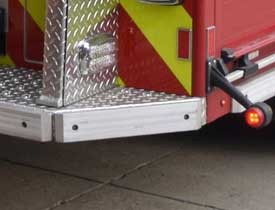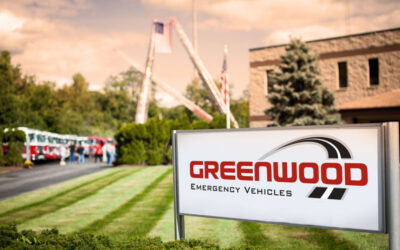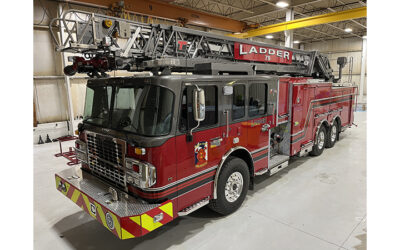By Bill Adams
All the purchasing specification said was, “The bumper shall be 95 inches wide with 45-degree corners and side plates.” Unless the reader is the preferred dealer who wrote the document, that statement has little to no intrinsic value. It’s possible the fire department itself may not know exactly what it is specifying and probably will not verify compliance after delivery—especially if it believed the vendor lock, stock, and barrel. Harsh words—perhaps true and worth discussing.

A typical front bumper extension with an atypical center-mounted discharge on top of the apron. It has slightly tapered corners with hose wells on each side of the frame rails.
National Fire Protection Association (NFPA) 1901, Standard for Automotive Fire Apparatus, Sentence 3.3.181* Turning Clearance Radius defines it as: “One-half of the larger of the left or right full circle wall-to-wall turning diameter.” NFPA 1901’s Appendix A notes that on apparatus where an aerial ladder extends beyond the front bumper, the turning radius will be larger. The only other place in NFPA 1901 I found any reference to turning radius was a question in Appendix B’s Apparatus Purchasing Specification Form: “What is the maximum wall-to-wall turning radius allowable?” NFPA 1901 defines a turning radius but does not require bidders to provide one or purchasers to ask for one.
Fire departments operating in congested urban and metropolitan areas with narrow streets and tight turns appreciate, and no doubt specify, apparatus with short wheelbases, limited front bumper extensions, and tight cramp angles—anything to avoid collisions when turning and maneuvering. Angled front bumper corners is another means to lessen the wall-to-wall turning radius—sometimes known as the front swing.
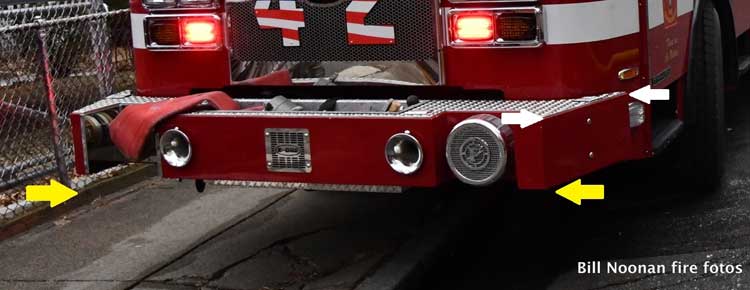
A very aggressive taper on a 16-inch bumper extension. The front face of the bumper (yellow arrows) is more than a foot narrower than the overall bumper width. The taper’s side sheet (white arrows) on this rig is 20-inches long. Bear in mind, bumpers do not provide 100 percent “swing protection” when turning. Some bumpers are 5 inches narrower than a cab’s width—and front fenderettes can stand off another couple inches.
Apparatus manufacturers (OEMs) have introduced bumpers advertised for “severe duty” and “inner city” service—although that type of service is not defined. One OEM offers flat stainless steel, structural steel, and formed steel bumpers. I offer no advice or recommendation for design or material. Let the vendors do that. Another manufacturer provides a “Turning Performance Analysis,” although it is unknown if it is its standard practice or a document that must be requested by the purchaser. It’s not a bad idea.
Suburban and rural departments often specify similar type bumpers—occasionally for reasons unknown to them. “Well, the city uses them—they must be good. Let’s buy two.” This is where a dilemma can arise. Many rural and suburban departments crave front bumper extensions to mount “stuff” ranging from booster reels to hydraulic tools, inlets, discharges, and decorative locomotive bells. Then, they want the front bumper corners tapered to help prevent hitting fixed objects. Some vendors might acquiesce to a purchasing committee’s whims and merely suggest the aforementioned, “The bumper shall be 95-inches wide with 45-degree corners and side plates.” That’s like fluffing them off. Most vendors cannot tell the fire department what the physical advantage to that specification is because there are too many variables. Ask the vendor what the cut back is. Is a 4-inch cut-back or an 8-inch cut back better? Is the 45-degree angle the best one to use? How much do you gain in the wall-to-wall turning radius? More importantly, how much does the fire department “want” to gain? When a bumper is aggressively tapered, the use of the area outboard of the chassis frame rails is affected. Is the fire department willing to lose that coveted storage space for a rig just to look like the city’s?
Tapering a front bumper will reduce a rig’s wall-to-wall turning radius. One manufacturer noted that parameters to be considered are the rig’s inside cramp angle, axle track, wheel offset, tread width, chassis overhang, front overhang, and wheelbase. Another manufacturer said a taper can be angled all the way back to the cab fascia to achieve the maximum reduction in the turning radius. Fire departments should prioritize their wants. A tapered bumper to achieve a minimal reduction in turning radius may not be cost effective. If your apparatus regularly runs into fixed objects, perhaps the bumper extension length itself should be addressed.
BILL ADAMS is a member of the Fire Apparatus & Emergency Equipment Editorial Advisory Board, a former fire apparatus salesman, and a past chief of the East Rochester (NY) Fire Department. He has 50 years of experience in the volunteer fire service.


